
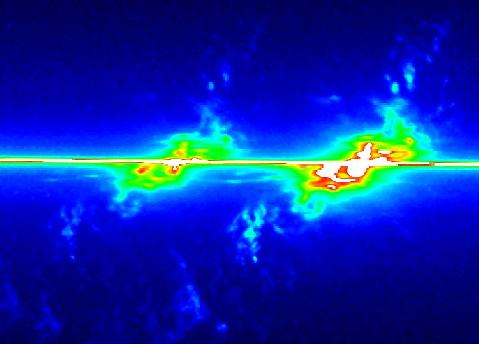
Add To Favorites
Glowing gas clouds are streaming from the core of galaxy NGC4151 at hundreds of thousands of miles per hour. A powerful tool, the Hubble Space Telescope's new STIS instrument, makes it possible to map out the cloud velocities - producing this false color "velocity map" for the central regions of NGC4151. The horizontal line is light from the intensely bright region near the galaxy nucleus. Emission at two wavelengths characteristic of Oxygen atoms in the gas clouds is visible along this line. Below the line the emission is displaced to the left, indicating motion toward us (blue shift); above the displacement is to the right indicating a receding motion (red shift). Where do the clouds come from? As evidence mounts, the widely accepted explanation for energetic nuclear activity in galaxies is based on material spiraling into a central black hole with over a million times the mass of our sun. The rotating disk of interstellar debris which develops is thought to blast out high velocity jets along the axis of the disk. Do all galaxies contain supermassive black holes?
1997-06-13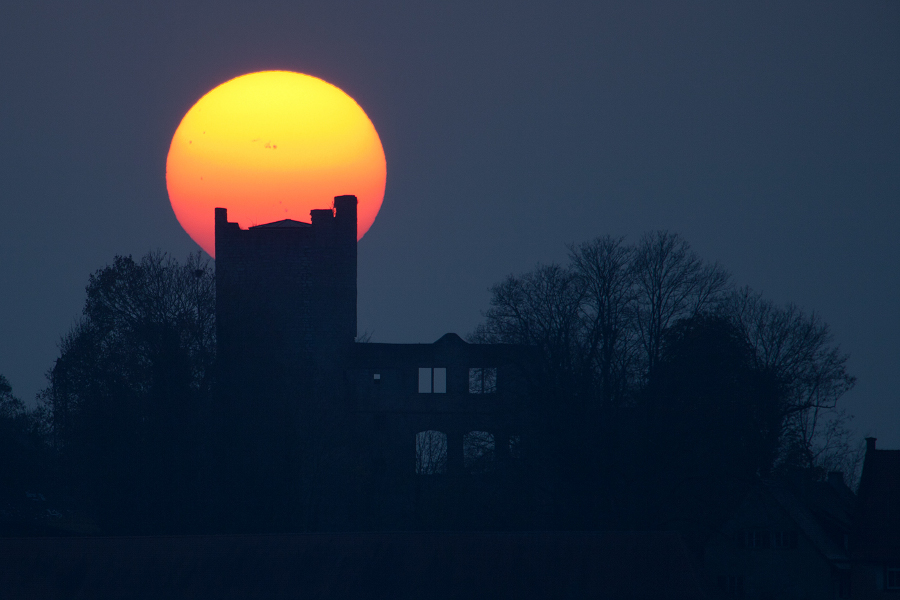
Add To Favorites
ch day can have a beautiful ending as the Sun sets below the western horizon. This week, the setting Sun added naked-eye sunspots to its finale, as enormous active regions rotated across the dimmed, reddened solar disc. Near the Sun's center in this closing telephoto view from November 7th are sunspots in Active Region 1339. Responsible for a powerful X-class flare on November 3rd, Active Region 1339 is larger than Jupiter. In the foreground, the ruined tower of a medieval castle stands in dramatic silhouette. Located in Igersheim, Germany and traditionally known as castle Neuhaus, it might be named Sunspot Castle for this well-composed scene.
2011-11-12 Jens Hackmann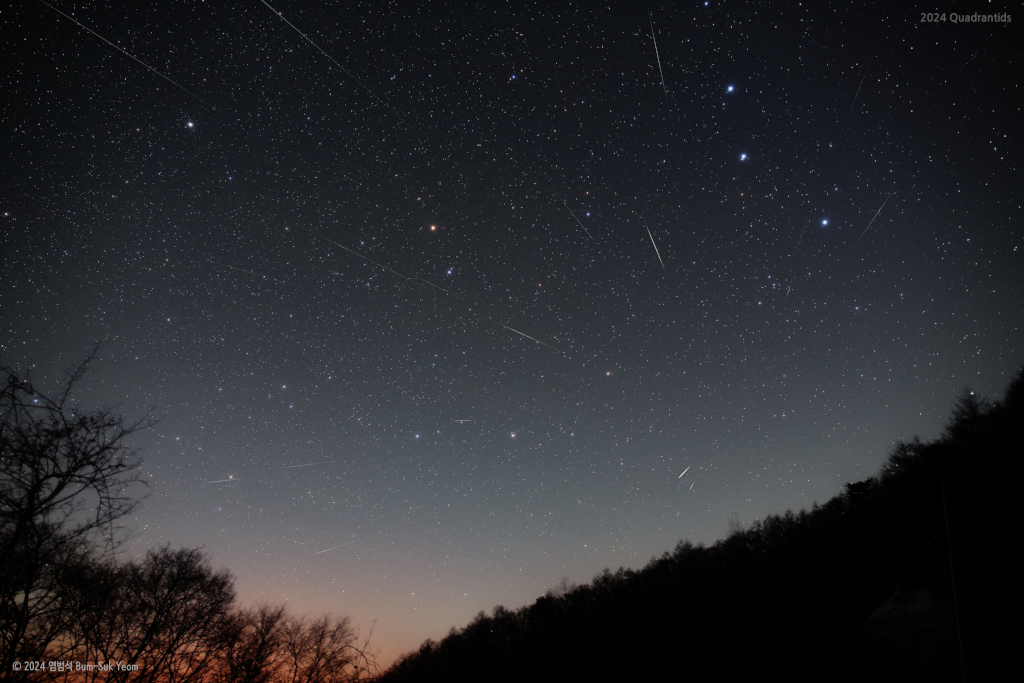
Add To Favorites
Named for a forgotten constellation, the Quadrantid Meteor Shower puts on an annual show for planet Earth's northern hemisphere skygazers. The shower's radiant on the sky lies within the old, astronomically obsolete constellation Quadrans Muralis. That location is not far from the Big Dipper asterism, known to some as the Plough, at the boundaries of the modern constellations Bootes and Draco. The Big Dipper "handle" stars are near the upper right corner in this frame, with the meteor shower radiant just below. North star Polaris is toward the top left. Pointing back toward the radiant, Quadrantid meteors streak through the night in this skyscape from Jangsu, South Korea. The composite image was recorded in the hours around the shower's peak on January 4, 2024. A likely source of the dust stream that produces Quadrantid meteors was identified in 2003 as an asteroid.
2024-01-11 염범석 Bum-Suk Yeom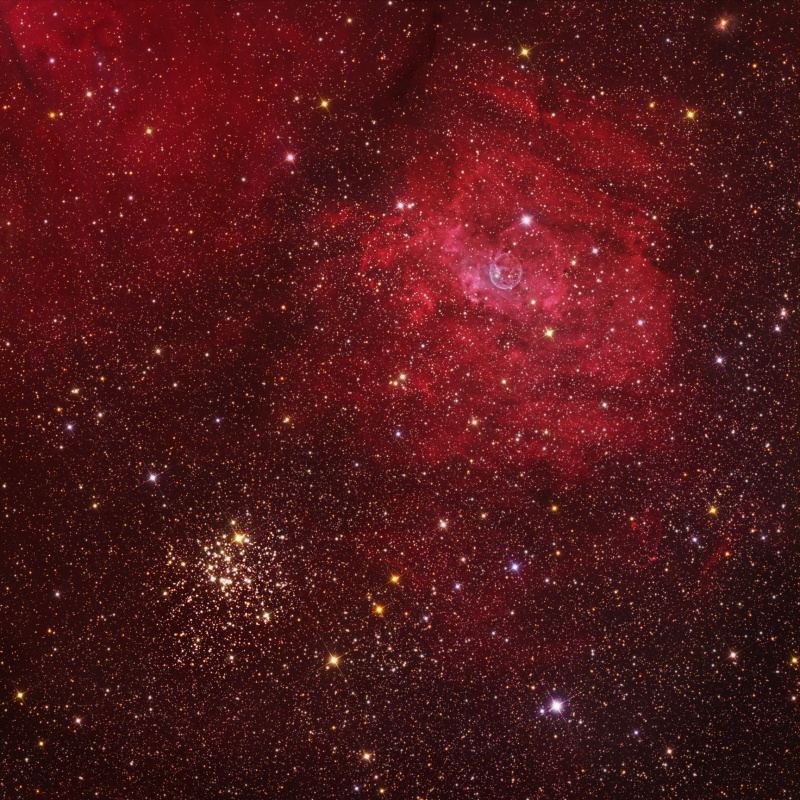
Add To Favorites
To the eye, this cosmic composition nicely balances the Bubble Nebula at the upper right with open star cluster M52. The pair would be lopsided on other scales, though. Embedded in a complex of interstellar dust and gas and blown by the winds from a single, massive O-type star, the Bubble Nebula (aka NGC 7635) is a mere 10 light-years wide. On the other hand, M52 is a rich open cluster of around a thousand stars. The cluster is about 25 light-years across. Seen toward the northern boundary of Cassiopeia, distance estimates for the Bubble Nebula and associated cloud complex are around 11,000 light-years, while star cluster M52 lies nearly 5,000 light-years away.
2009-10-30 Tony Hallas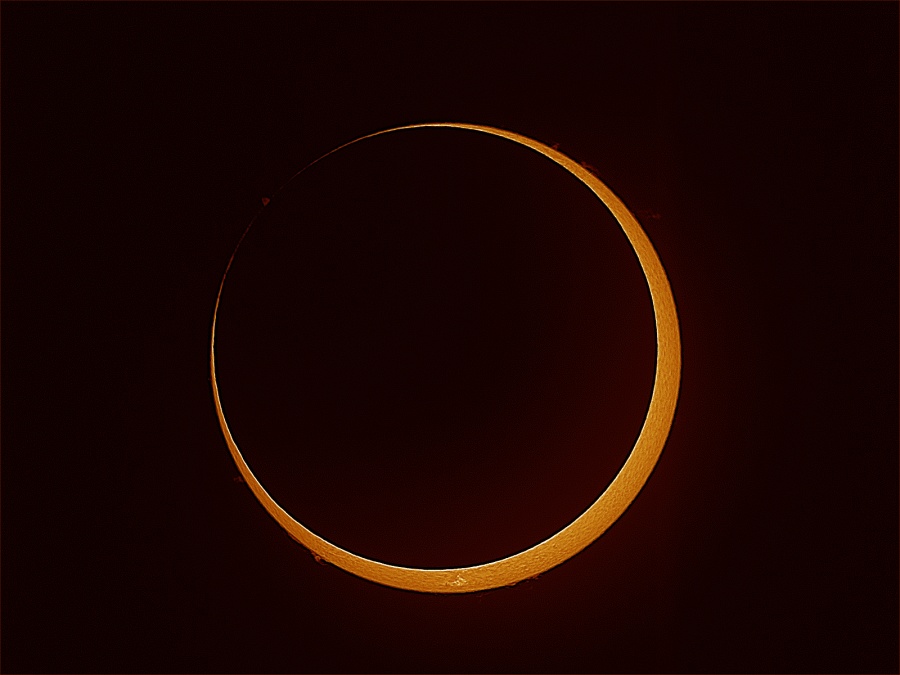
Add To Favorites
It's eclipse season, and on April 29 around 06:00 UT the shadow of the new Moon will reach out and touch planet Earth, though only just. Still, if you're standing on the continent of Antarctica within a few hundred kilometers of 79 degrees 38.7 minutes South latitude and 131 degrees 15.6 minutes East longitude you could see an annular solar eclipse with the Sun just above the horizon. Because the Moon will be approaching apogee, the most distant point in the elliptical lunar orbit, its apparent size will be too small to completely cover the solar disk. A rare, off-center eclipse, the annular phase will last at most 49 seconds. At its maximum it could look something like this "ring of fire" image from last May's annular solar eclipse, captured by a webcast team operating near Coen, Australia. Otherwise, a partial eclipse with the Moon covering at least some part of the Sun will be seen across a much broader region in the southern hemipshere, including Australia in the afternoon.
2014-04-26 MWV Observatory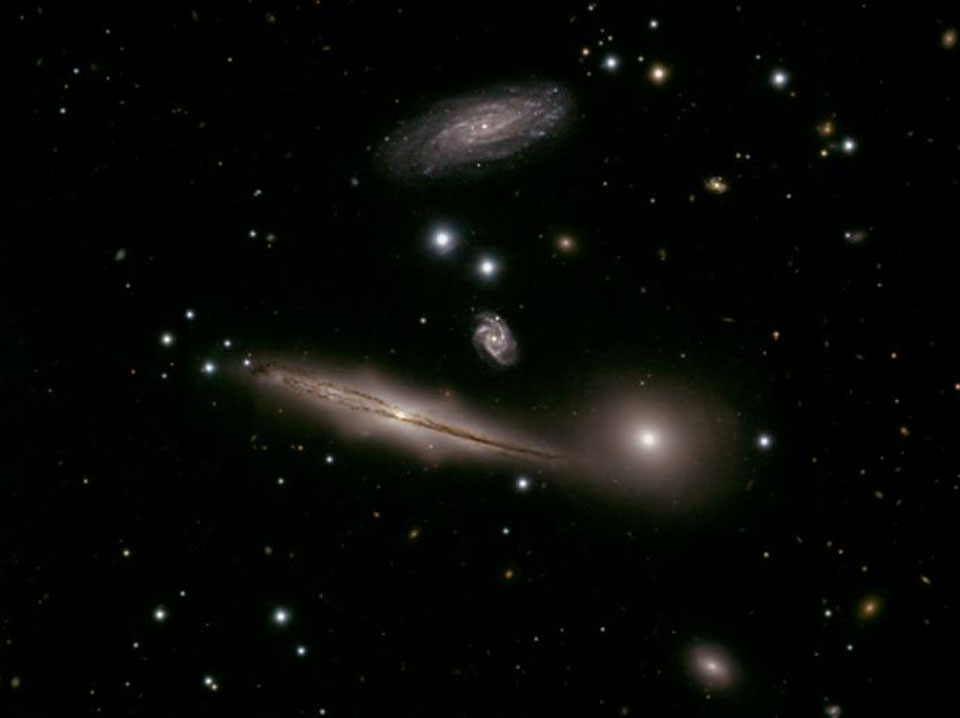
Add To Favorites
Sometimes galaxies form groups. For example, our own Milky Way Galaxy is part of the Local Group of Galaxies. Small, compact groups, like Hickson Compact Group 87 (HCG 87) shown above, are interesting partly because they slowly self-destruct. Indeed, the galaxies of HCG 87 are gravitationally stretching each other during their 100-million year orbits around a common center. The pulling creates colliding gas that causes bright bursts of star formation and feeds matter into their active galaxy centers. HCG 87 is composed of a large edge-on spiral galaxy visible near the image center, an elliptical galaxy visible to its right, and a spiral galaxy visible near the top. The small spiral near the center might be far in the distance. Several stars from our Galaxy are also visible in the foreground. Studying groups like HCG 87 allows insight into how all galaxies form and evolve. Follow APOD on: Facebook, Google Plus, or Twitter
2015-08-09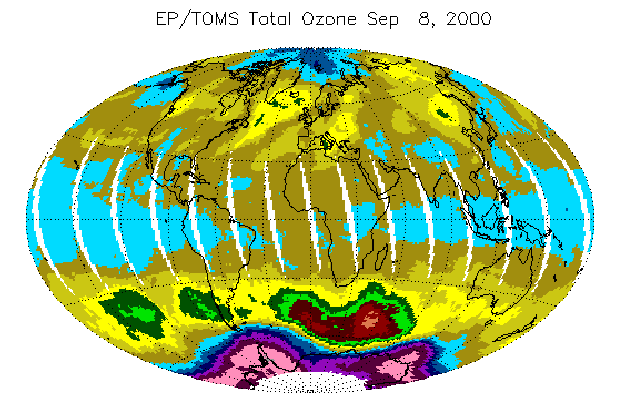
Add To Favorites
It's back, and it's bigger than ever. The ozone hole that has been a cause of concern in recent years has again reformed over Earth's South Pole. The seasonal recurrence of the ozone hole was expected, although the size of the hole has never been so large this early in the season. Ozone is important because it shields us from damaging ultraviolet sunlight. Ozone is vulnerable, though, to CFCs and halons being released into the atmosphere. The ozone hole's large size is probably related to unusually low temperatures, allowing CFC byproducts like chlorine to react with atmospheric ozone molecules with greater efficiency. In the above false-color picture taken earlier this month, low ozone levels are shown in red and grey.
2000-09-11
Add To Favorites
At full throttle the Deep Space 1 spacecraft's innovative ion drive produces about 1/50th of a pound of thrust ... a force so great that it would just about hold up a piece of paper on planet Earth! Still, powered by solar arrays ion propulsion systems can run continuously. For long duration space missions they ultimately win out over the powerful but brief blasts of less efficient chemical rockets. Deep Space 1 is seen here suspended in an assembly room, a folded solar array resting above the circular ion propulsion module. Already a successful technology demonstrator with experimental autonomous software, the spacecraft flew by asteroid 9969 Braille in July of 1999 but later that year, in November, the robot probe was nearly lost due to the failure of its wide-field star tracker camera. Now, the adventures of Deep Space 1 can continue. Engineers were able to reprogram the navigation system to utilize another on-board camera and on 28 June 2000 the ion drive was throttled up. Once again steering by the stars, Deep Space 1 is presently bound for a September 2001 rendezvous with periodic Comet Borrelly.
2000-08-31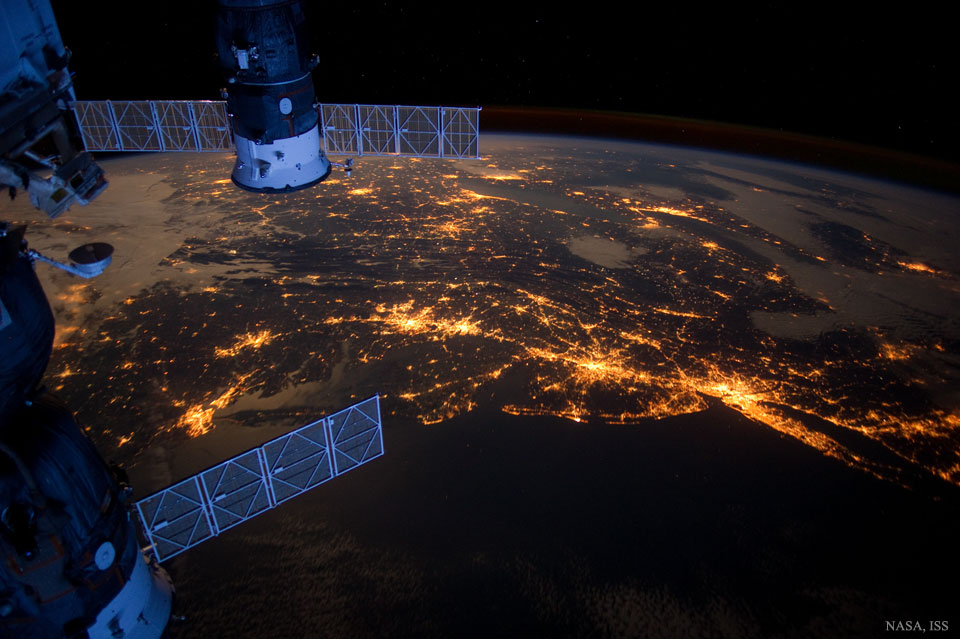
Add To Favorites
Can you identify a familiar area in the northeast USA just from nighttime lights? It might be possible because many major cities are visible, including (right to left) New York, Philadelphia, Baltimore, Washington, Richmond and Norfolk -- Boston of the USA's Northeast megalopolis is not pictured. The featured image was taken in 2012 from the International Space Station. In the foreground are two Russian cargo ships with prominent solar panels. This Northeast megalopolis of the USA contains almost 20 percent of the people of the USA but only about 2 percent of the land area. Also known also as the Northeast Corridor and part of the Eastern Seaboard, about 10 percent of the world's largest companies are headquartered here. The near continuity of the lights seem to add credence to the 1960s-era prediction that the entire stretch is evolving into one continuous city.
2016-02-24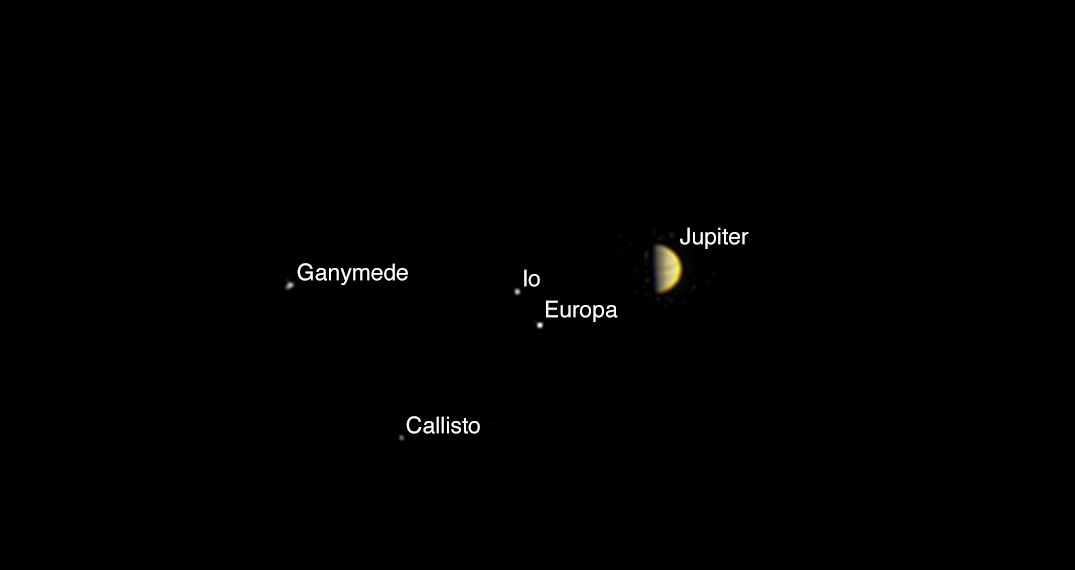
Add To Favorites
Approaching over the north pole after nearly a five-year journey, Juno enjoys a perspective on Jupiter not often seen, even by spacecraft from Earth that usually swing by closer to Jupiter's equator. Looking down toward the ruling gas giant from a distance of 10.9 million kilometers, the spacecraft's JunoCam captured this image with Jupiter's nightside and orbiting entourage of four large Galilean moons on June 21. JunoCam is intended to provide close-up views of the gas giant's cloudy zoned and belted atmosphere. On July 4 (July 5 UT) Juno is set to burn its main engine to slow down and be captured into its own orbit around the giant planet. If all goes well, it will be the first spacecraft to orbit the poles of Jupiter, skimming to within 5,000 kilometers of the Jovian cloud tops during the 20 month mission.
2016-07-01